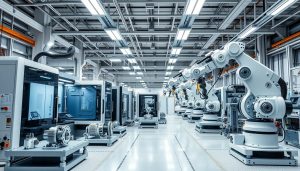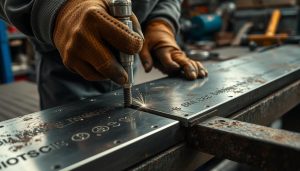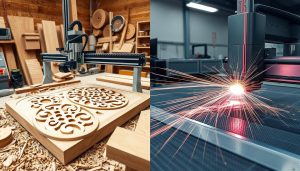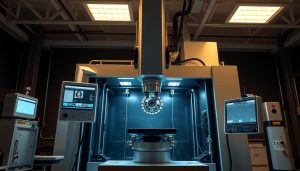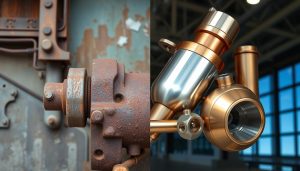In the dynamic landscape of modern manufacturing, a revolutionary metal forming technique is emerging as a game-changer – squeeze casting. This innovative process combines the advantages of forging and casting, offering a powerful solution for creating advanced metal components with exceptional quality and precision. As the manufacturing revolution continues to unfold, squeeze casting is poised to reshape various industries, from automotive and aerospace to industrial equipment, by delivering superior strength, reduced defects, and heightened efficiency.
What is Squeeze Casting?
Squeeze casting is a unique metal forming process that combines the benefits of traditional casting and forging techniques. This hybrid approach allows manufacturers to create high-quality, precision metal components with superior mechanical properties.
Definition and Overview of Squeeze Casting
At its core, squeeze casting is a specialized casting process where molten metal is injected into a mold and then subjected to high pressure. This pressure is maintained throughout the solidification stage, resulting in a dense, defect-free casting with enhanced strength and durability.
How Squeeze Casting Combines Casting and Forging
Squeeze casting integrates elements of both casting and forging to produce superior metal components. Like traditional casting, the process begins with pouring molten metal into a mold. However, instead of allowing the metal to solidify under gravity alone, a powerful hydraulic press applies and maintains high pressure during the solidification phase. This combination of casting and forging techniques leads to improved microstructural properties, reduced porosity, and enhanced mechanical characteristics in the final product.
“Squeeze casting is a highly versatile metal forming process that leverages the best of both casting and forging to create high-performance components.”
The Squeeze Casting Process
Squeeze casting, a versatile metal forming process, combines the advantages of traditional casting and forging techniques. This innovative approach offers a unique solution for producing high-quality, defect-free components with superior material properties. Let’s delve into the step-by-step details of the squeeze casting process and explore the crucial role of pressure in this remarkable technology.
Step-by-Step Breakdown of Squeeze Casting
- Mold Preparation: The process begins with the preparation of a specialized mold, designed to withstand the high pressures involved in the squeeze casting process.
- Metal Pouring: Molten metal is carefully poured into the pre-heated mold, ensuring a smooth and uniform fill.
- Pressure Application: Immediately after pouring, a powerful hydraulic press applies significant pressure to the molten metal, typically ranging from 50 to 150 MPa (7,250 to 21,750 psi).
- High-Pressure Solidification: The applied pressure accelerates the solidification process, resulting in a dense, defect-free casting with superior material properties.
The Role of Pressure in the Squeeze Casting Process
The key to the success of squeeze casting lies in the high-pressure solidification stage. The intense pressure applied during this phase forces the molten metal to fill the intricate details of the mold, effectively reducing porosity and other casting defects. This pressure-assisted solidification also enhances the material’s strength, ductility, and overall integrity, making squeeze-cast components ideal for demanding applications in industries such as automotive and aerospace.

“The application of pressure during solidification is the defining feature of the squeeze casting process, as it enables the production of high-quality, near-net-shape components with exceptional material properties.”
Advantages of Squeeze Casting
Squeeze casting is a highly efficient manufacturing process that offers a range of benefits for various industries. By combining the strengths of casting and forging, this technique delivers superior enhanced material properties and significantly reduced defects in the final components.
Superior Strength and Material Integrity
One of the primary advantages of squeeze casting is its ability to produce parts with exceptional strength and material integrity. The high-pressure application during the casting process results in a denser, more uniform microstructure, leading to enhanced mechanical properties such as tensile strength, fatigue life, and wear resistance.
High-Quality, Heat-Treatable Components
Squeeze casting enables the manufacture of high-quality, heat-treatable components that are suitable for a wide range of applications. The process ensures a consistent, homogeneous material composition, making it easier to apply heat treatment and achieve desired mechanical properties, such as hardness and ductility.
Reduced Porosity and Defects in Castings
Compared to traditional casting methods, squeeze casting significantly reduces the occurrence of porosity and other common casting defects. The high pressure applied during the process forces the molten metal to fill the mold cavities completely, resulting in castings with exceptional defect reduction and improved overall quality.
These advantages of squeeze casting make it an attractive choice for industries that demand high-performance components with enhanced material properties and reduced defects, such as automotive, aerospace, and industrial equipment manufacturing.
Challenges and Limitations of Squeeze Casting
While squeeze casting offers numerous advantages, it also comes with its fair share of challenges and limitations. Understanding these factors is crucial for businesses considering adopting this manufacturing process.
High Setup Costs and Complexity
Implementing a squeeze casting system requires significant upfront investment. The specialized equipment, molds, and tooling needed can be expensive, making it a less accessible option for smaller operations. Additionally, the process itself is complex, requiring skilled technicians to operate the machinery and monitor the various stages of production.
Suitable Materials for Squeeze Casting
Squeeze casting is best suited for materials that can withstand the high pressures and temperatures involved in the process. Aluminum alloys and magnesium alloys are commonly used in squeeze casting, as they possess the necessary material compatibility with the process. However, squeeze casting limitations may exist for certain materials, such as ferrous alloys, which may require specialized equipment or modifications to the process.
| Material | Compatibility with Squeeze Casting |
|---|---|
| Aluminum Alloys | Excellent |
| Magnesium Alloys | Excellent |
| Ferrous Alloys (Steel, Iron) | Limited |
Careful material selection and process optimization are essential to overcome the challenges and limitations of squeeze casting, ensuring the production of high-quality, defect-free components.

Applications of Squeeze Casting
Squeeze casting has found widespread applications across various industries, showcasing its versatility and the benefits it offers in producing high-performance components. Two key sectors where this manufacturing technique shines are the automotive and aerospace industries.
Use in Automotive and Aerospace Industries
In the automotive industry, squeeze casting is widely used to create a range of components, including engine blocks, transmission housings, and suspension parts. The process enables the production of lightweight yet durable automotive components that are critical for enhancing vehicle performance, efficiency, and safety.
Similarly, the aerospace industry leverages squeeze casting to manufacture complex, high-precision aerospace applications such as aircraft engine parts, landing gear components, and structural elements. The superior material properties and dimensional accuracy achieved through squeeze casting make it an ideal choice for these mission-critical aerospace applications.
Applications in Industrial Equipment Manufacturing
Beyond the automotive and aerospace sectors, squeeze casting also finds applications in the production of various industrial equipment and machinery. Components like hydraulic valve bodies, gear housings, and structural parts for construction equipment often benefit from the advantages offered by the squeeze casting process.
| Industry | Squeeze Casting Applications |
|---|---|
| Automotive | Engine blocks, transmission housings, suspension parts |
| Aerospace | Aircraft engine parts, landing gear components, structural elements |
| Industrial Equipment | Hydraulic valve bodies, gear housings, construction equipment parts |
The diverse applications of squeeze casting across these industries underscore the versatility and value this manufacturing technique brings to the table, enabling the production of high-quality, durable, and precisely engineered components.
Why Choose Shixinproto for Your Squeeze Casting Needs?
When it comes to precision manufacturing and superior squeeze casting solutions, Shixinproto stands out as a trusted industry leader. With our advanced equipment, skilled workforce, and unwavering commitment to quality, we deliver exceptional squeeze cast components that meet the demanding requirements of diverse industrial applications.
Shixinproto’s extensive squeeze casting services are backed by decades of manufacturing expertise and a proven track record of delivering innovative solutions. Our state-of-the-art facilities are equipped with the latest technology, enabling us to seamlessly integrate squeeze casting into our comprehensive manufacturing processes.
What truly sets Shixinproto apart is our dedication to quality. We employ rigorous quality control measures throughout every stage of production, ensuring that each squeeze cast part exceeds the highest standards. Our skilled engineers work closely with clients to understand their unique requirements and tailor our solutions accordingly, guaranteeing exceptional performance and reliability.
